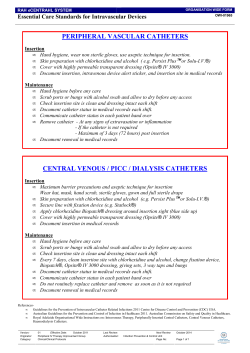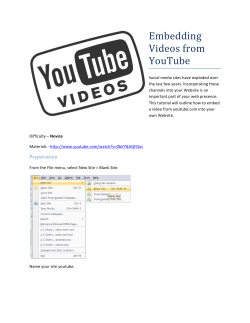
Today • AM - Seminar - 3157
Today • AM - Seminar - 3157 – – – – Get Casts from Marjorie Survey Class I & II Casts (no preps) Tripod Casts Get Heads & Mounts ready for PM • PM - Clinic – Prepare guiding planes on Class I & II Typodonts (last sheet Course Sched) – Formative – Marking sheets – Diagnostic Casts Mark Sheets - Hand in Surveying, Path of Insertion, Guiding Planes Definitions • Height of contour • Undercut = Infrabulge • Suprabulge Definitions • Height of contour • Undercut = Infrabulge • Suprabulge Rule: Retentive tip should usually be designed to be placed in the gingival 1/3 Path of Insertion • Path that the prosthesis is –Placed/removed –Usually a single path Advantages of a Single Path of Insertion • Equalizes retention Advantages of a Single Path of Insertion • Bracing and Cross-arch Stabilization Advantages of a Single Path of Insertion • Minimizes torque on abutments Advantages of a Single Path of Insertion • Allows removal without encountering interferences Advantages of a Single Path of Insertion • Directs forces along long axes of teeth Advantages of a Single Path of Insertion • Provides frictional retention Selecting a Single Path of Insertion • Use a dental surveyor to –Select path –Prepare guiding planes Guiding Plane Preparation • Where rigid components contact abutments • Proximal Plates • Bracing Arms • Rigid portions of Retentive Arms Other Uses of a Surveyor • Blocking out undesirable undercuts –Ensures the framework is not cast in an undercut Parts of a Surveyor • Surveying Table Parts of a Surveyor • Surveying Arm Parts of a Surveyor • Surveying Tools –Analyzing Rod Parts of a Surveyor • Surveying Tools –Carbon Markers Parts of a Surveyor • Surveying Tools –Undercut Gauges . 01” . 02” . 03” Undercut Gauges Parts of a Surveyor • Surveying Tools –Wax Trimmer Selecting a Path of Insertion • Orient cast relatively horizontal –Final tilt rarely more than 10° from horizontal Selecting a Path of Insertion • Place analyzing rod against abutments – Contact point is Height of Contour - Below is infrabulge - Above is suprabulge Selecting a Path of Insertion • Tilt cast to obtain maximum parallelism – Heights of contour are at relatively same position occluso-gingivally – Equal amounts of undercut Altering Path of Insertion • Proximal surfaces similar undercuts • Retentive areas similar undercuts Selecting a Path of Insertion • Modify tilt if necessary – Soft tissue interferences Selecting a Path of Insertion • Modify tilt if necessary –Esthetics Once Path Selected • Instructor: –Approves path –Demo: - Mark heights of contour with carbon marker - Tripod Selecting a Path of Insertion • Lock cast position & tripod Tripoding Optimal Path of Insertion • Retentive undercuts equalized –Retentive arm has a different path of escapement than guiding plane, so it must flex during removal Optimal Path of Insertion • Retentive undercuts equalized – Ideally, retentive arms should oppose each other on opposite sides of the arch Optimal Path of Insertion • Minimize severe tooth & soft tissue interferences Optimal Path of Insertion • Esthetics –Minimize display of clasps, metal components Optimal Path of Insertion • Prepare Guiding Planes –Flat surfaces parallel to path of insertion –Control & limit movement of RPD –Initial contacts for RPD Guiding Planes • Stabilization Effectiveness of Guideplanes • Most effective when: –Parallel to each other –More than one common axial surface Effectiveness of Guideplanes • Most effective when: –Directly opposing each other Effectiveness of Guideplanes • Most effective when: –Prepared on several teeth –Cover a large surface area Assessing Guiding Planes Proximal View Facial View Carbon Markings Preparing Guiding Planes • Select path of insertion • Design Partial Denture * • Select number & position of guiding planes • Prepare guiding planes Use Surveyor to Align Bur Intraorally FINGER REST! Burs 8837K-014 • Long Cylindrical Carbide or Diamond (8837K 014) Guiding Plane Dimensions 2-4 2-4 mm mm 1/2-1/3 1/2-1/3 height height Round Round Axial Axial Line Line Angles Angles Axial Surface Already Parallel to Path of Insertion • NO Preparation ! Polish Prepared Surfaces • Rubber wheels or points Prepare Guiding Planes First Effects of Guiding Planes On Retention & Stability • Maintains Retention Effects of Guiding Planes On Retention & Stability • Minimizes Need for Retention Effects of Guiding Planes On Retention & Stability • Stabilizing Teeth Use Use short short guideplanes guideplanes on on Class Class II & & IIII Use Use long long guideplanes guideplanes on on Class Class III III & & IV IV Other Alterations of Axial Contours • Lowering Heights of Contour – Rigid elements contacting abutments – Improve esthetics – Prepare guiding planes most efficient method to lower Other Alterations of Axial Contours • Raising Heights of Contour – Insufficient retention in gingival 1/3 (at least 1mm from gingiva) – Prepare undercut – Add resin above to create undercut Preparing Retention • Axial surface must be close to parallel the path of insertion X Retentive Preparation Shape • Follows the path of designed retentive tip X X Creating Undercuts with Bonded Resins • Axial surface must be close to parallel the path of insertion X Summary of Abutment Modifications • After RPD Designed – Guideplanes – Lower heights of contour to eliminate interferences & improve esthetics – Create undercuts if absolutely necessary (raising heights of contour) – Rest seat preparation
© Copyright 2025










